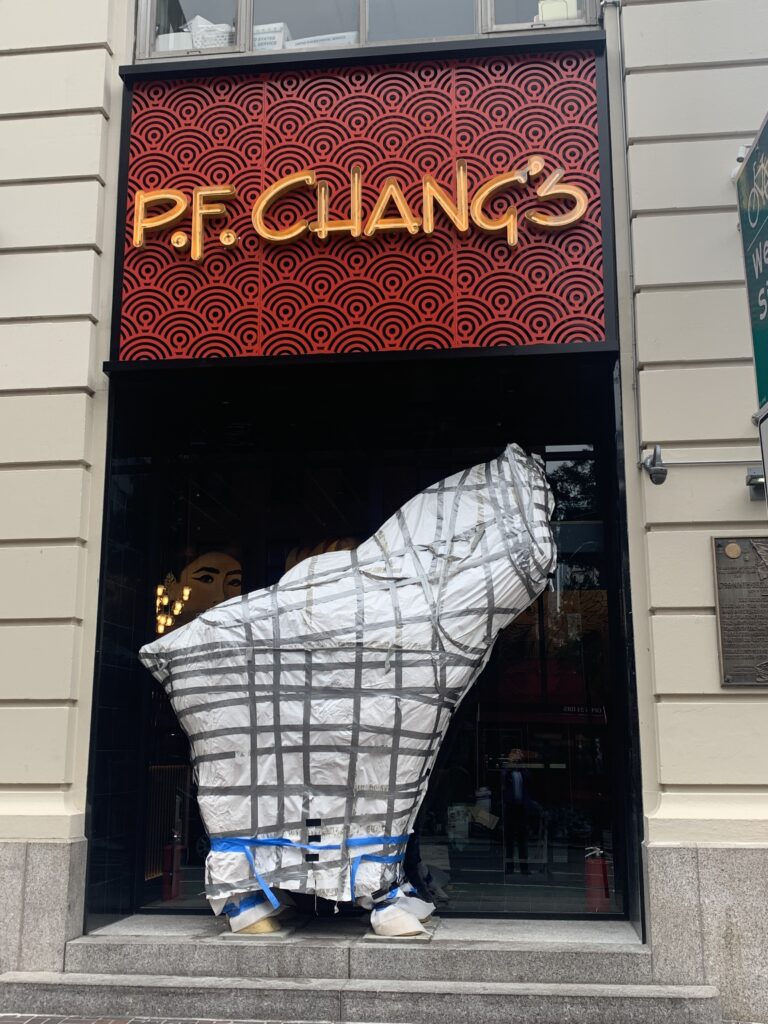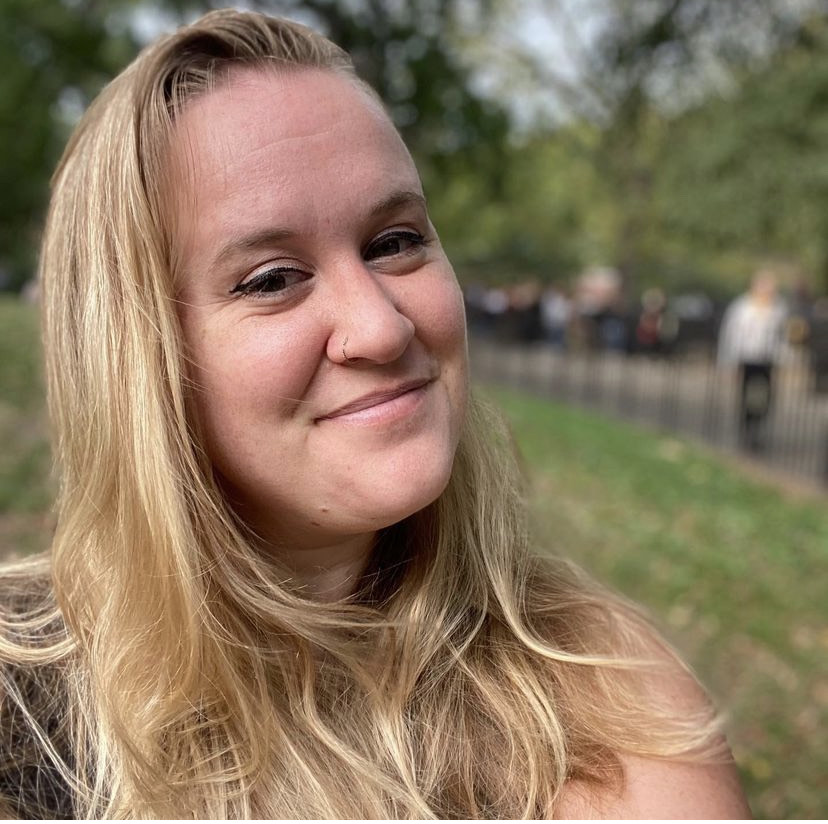The 14th Street Path of Empathy
By Harley J. Spiller aka Inspector Collector

(photo by Harley J. Spiller)
It was exciting to be invited by Jessica Blinkhorn, curator and Ed Woodham, founder, to serve as a Thinker in Residence for this year’s Art in Odd Places festival. I started taking notes at 12:08 pm on Sunday September 25th, the closing day of the annual public art event, as the 4 express subway wound its way downtown. Performance artist and friend Chin Chih Yang had texted the night before to say he’d be in Union Square performing in memory of Mahsa Amini, a 22-year old woman who died in government custody after having been accused of not properly wearing a scarf. Turns out Chin Chih wasn’t part of this year’s AiOP, but when a large art project takes place in a huge public sphere, there’s no telling who what where when or why such things might coincide.
I set out to walk the entire length of 14th Street as I’d done when participating as an artist in AiOP 2019: Invisible, and got to the Con Ed plant on Avenue C, and back to Avenue A before I encountered the first artist, a person performing as a boxy robot – they did not speak but were clearly happy to stop and field my reactions and inquiry – “can you communicate in other ways than nodding yes or no?” The robot took out a hand-held battery operated child’s football game and made it beep in response. That served as a perfect summation of the depth of communication often achieved in today’s screen-addicted world of interpersonal exchange.
Delightful AiOP staffers womanning the table in front of the 14th Street Y (which kindly offered its bathrooms for participants) told me that as in years past, most of the art action takes place on the West side of the 2-mile 2-way road. By the time I got back to Union Square Park it was time for Chin Chih’s event so I handed out his flyers and encouraged passersby to take one of 22 black scarves he’d collected and wrap him in it. It’s never easy encouraging the unsuspecting public to take part in art, but in about half an hour Chin Chih was covered and began his actions to bring peace and sanity back to humanity. Two Taiwanese artists, Hsiao-Chu Hsia, and Chen-Yi Wu, stopped by to support the performance on route to their AiOP walk, which involved Shou-An Chiang, a third artist who would be participating in their hybrid piece from London, England. And then along came Animaenoctis.com, a man in a wedding dress and a woman with a pencil thin mustache, asking if Art Can Really Transform – when they learned I was an AiOP thinker, the uomo (perhaps) parted with the amusing words “have good thoughts” – later they were espied in performance, pushing each other on a rickety metal wheeled cart. He hit me with another corker: “lots to think about eh?”
Further west I spotted a performer in all white, with a plastic Key Food supermarket bag tied around her head with just her eyes peeping out two tiny holes. Yu-Ching Wang had suffered discrimination in public and chose this method to share her emotions about identity – her experience was horrible and one hopes this piece will change things for the better, as much of the AiOP work this year seems aimed at achieving. And then there he was, AiOP’s founder himself, staffing an info table. I charged forward and had a lovely chat with Ed Woodham, who sat me on a collapsible stool (that didn’t collapse), plied me with a sticker that says “NOTHING,” and shared stories personal, political and world-beating. Most of all I loved our discussion about how serendipity plays a big role in AiOP*, and in life in general (at the flea markets on the sidewalk between Avenues A and B I couldn’t resist buying a used copy of The Sleeve Should Be Illegal: & Other Reflections on Art at the Frick. The vendor asked how much would I pay – and I said “how ‘bout a couple bucks?” She said “OK how about 3.” Wouldn’t you know it but 3 participants in AiOP asked to take a photo of the cover of the book – go figger the odds of that trinary.)
The inimitable LuLu LoLo popped up next, brightening the grey-ish day in her bright red raincoat and brighter red heart. On I marched and next encountered Ana De Orbegoso and her Power Cart (Feminist Projections), a selection of beautifully crafted vests with sharp embroidered statements – walking with her and her helper Daphna I encountered another thinker, Rich Garr, who had years earlier been introduced by Cleveland artist and friend Jeff Chiplis – the whole world collides on 14th Street sometimes and we’re all the better for this crossroads of the world (especially in light of the un-New-York commercialization of The Deuce, the original crossroads of the world!). Next up we watched Tamara Wyndham, also in white, paint her message “All that we have created will decay” – in water – on the sidewalk – now that’s graffiti no one can get in trouble for!
Time ran out. I didn’t make it all the way to the Hudson but did get one last art work under my belt, and a beaut it was. Vivek Sebastian spent half an hour or so asking me deep questions and crafting a custom Talisman in Situ to bring me power and strength with a personal issue I cogitated but did not reveal. Vivek nobly accepted my limits and asked “around” my topic, and made me a lotto-ticket amulet laden with special powders and spices and two x 3 safety pins, doubling down on the number of the day. Vivek proves that he cares deeply about people, has powerful ears, and is a humanitarian par excellence.
In fact all the artists I encountered were humanitarians on a mission to make the world a better place. No small feat for individuals and couples but an essential goal. It is such empathy that stood out as the ultimate message of the festival. Thank you Jessica and Ed and Furusho and many others who made me once again proud to be a fellow artist and arts administrator.
*the American-Chinese restaurant chain P.F. Chang’s new location on University Place at 13th Street channels Christo and Jeanne Claude. Regardless that this “wrapped Tang horse” is not intended as art, art can be found anywhere one seeks.
Harley J. Spiller performed “Invisibilicious” at AiOP 2019: INVISIBLE. Harley is the Ken Dewey Director of Franklin Furnace Archive, where he has supported the purportedly unsupportable since 1986. He is psyched to work again alongside Jessica Blinkhorn, 2022 AiOP Curator, and is looking forward to experiencing the wild n wooly artists she is sure to have selected for NYC’s delectation.



